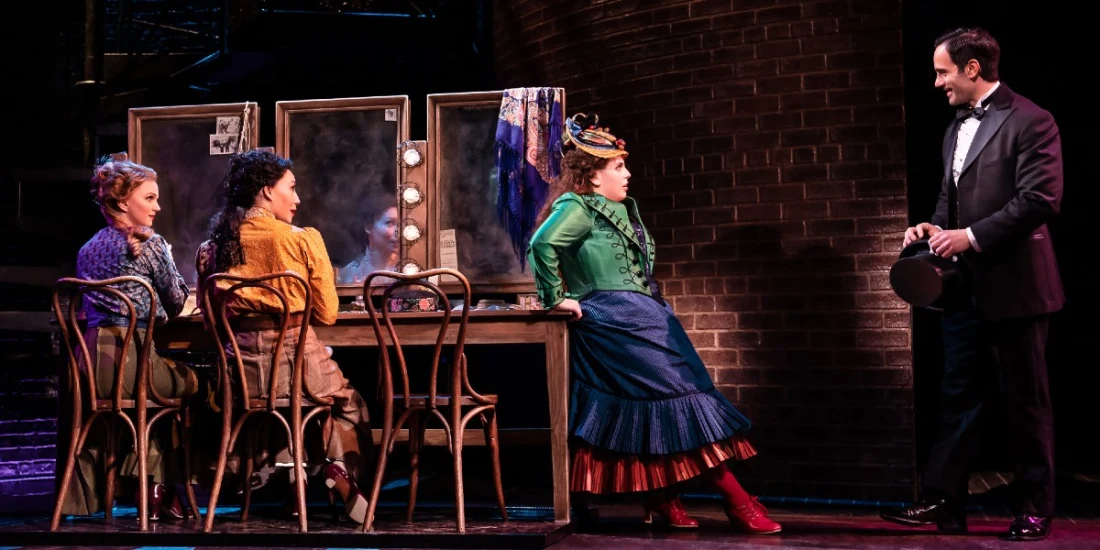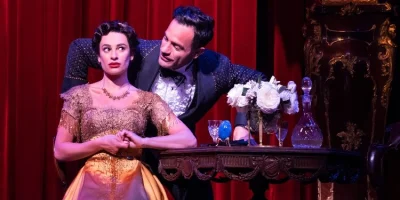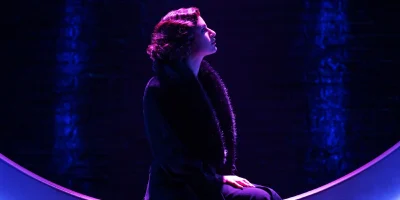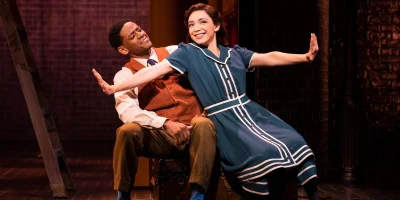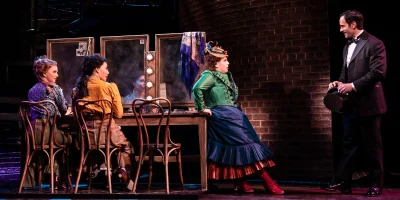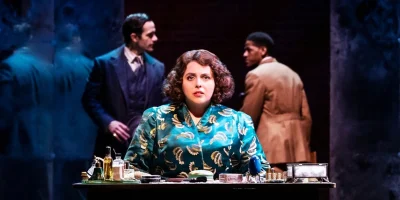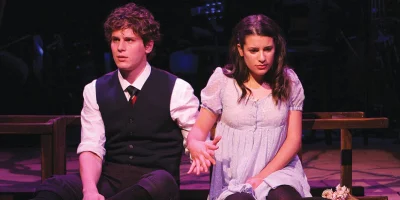
Learn about the showbiz history that inspired 'Funny Girl' on Broadway
Discover how the real lives of Fanny Brice and Nick Arnstein inspired the hit musical and what got changed for the stage.
If the only Funny Girl history you know is that Barbra Streisand first starred in it, then get ready, love, because we're a-comin' to tell you there's so much more than that. This musical is currently having its first Broadway revival, bringing the story of 20th-century vaudeville icon Fanny Brice to a whole new audience. The show — which stars Lea Michele, Ramin Karimloo, and Tovah Feldshuh — focuses on how Fanny (Feldstein) reaches the height of her career as she falls for the gambler Nick Arnstein (Karimloo) and puts everything on the line.
Though Funny Girl debuted on Broadway in 1964, the story of the show truly begins in the 1910s, when the real Fanny joined the original company of the Ziegfeld Follies. Funny Girl takes plenty of liberties with the life and career of its star, but the show is ultimately rooted in a true story about the young woman's love life and her mark on a revue that shaped today's Broadway landscape.
This primer is spoiler-free, so learning more about what's fact and what's fiction in this musical won't rain on your parade. Once you're a Funny Girl expert and people ask "Who Taught Her Everything?", you can say you learned all about Brice, Arnstein, and more right here.
1910s New York
Funny Girl starts off in post-World War I America, when Fanny Brice is looking back on her stage career and marriage up to that point. Most of the musical is told in flashbacks to pre-war America, showing Fanny's career taking off. This is a little different from real life: Fanny did start her career pre-war, in 1910, but she mostly performed in the Follies from 1921 onward and became a smash hit then. All of Funny Girl, in contrast, takes place before 1924.
So what was the pre-war era like? In the 1910s, New York as we know it today — with five boroughs in one city — was just over 10 years old. Lots of new skyscrapers, schools, and transportation routes were built. As the mid-1910s approached and World War I began, there was a shift in the national mood, but it didn't stop the city's culture from flourishing. People were looking for an escape from, and/or an outlet to cope with, wartime worry, which arts and culture provided.
Uptown, the influx of African Americans looking for work started the Harlem Renaissance, and further downtown, spectacular shows like the Ziegfeld Follies let people step into a joyful, glamorous world for a few hours. Of course, not everyone was able to distance themselves from the turmoil of war — outside the theatre, Jewish residents especially experienced widespread hate when the war temporarily stopped immigration. But on a positive note, that's what makes Funny Girl notable — the story celebrates a Jewish woman who was able to succeed in a difficult era.

Ziegfeld Follies
Fanny Brice not only got her start with the Ziegfeld Follies, but also performed with the show for decades. But don't get the Follies confused with the Sondheim musical Follies — the early-20th-century series, founded by and named after Florenz Ziegfeld, doesn't have a singular plot. The Follies were basically high-end variety shows: acts like songs, dance numbers, comedy routines, acrobatics, magic, and more were all lumped into one epic show.
If you're familiar with Chicago, whose musical numbers are staged like the music, circus, and puppetry acts of 1920s vaudeville shows, you have an idea of what Follies shows were like. Plus, the Follies actually paved the way for today's Broadway musicals. Audiences loved the spectacle of the Follies: its glitzy sets and costumes, its over-the-top performances, its large ensembles. Think of grand musicals like Moulin Rouge! The Musical, MJ, and even Funny Girl itself that attract Broadway audiences now — you can trace their flashy style back to Ziegfeld.
The Follies themselves were on Broadway from 1907 to 1931, and the act was revived in 1934 and 1936. Since radio was the hot new medium at the time, a Follies radio show, The Ziegfeld Follies of the Air, also ran from April 1932 to June 1936. Most of the episodes have been lost, but we know Fanny Brice participated in Follies shows both on stage and on the air.
Funny Girl focuses on Brice's stage career with the Follies. The beginning of the musical sees her dream of a career in vaudeville, and meeting Ziegfeld opens the door for her big break. Another character, Eddie Ryan, played by Tony nominee Jared Grimes, is also a vaudeville dancer who helps her succeed (in between wowing audiences with captivating dancing of his own).
Fictionalized snippets of Ziegfeld performances are part of the musical, complete with all the high-energy dancing, song, comedy, and lavish period costumes. In one of these numbers, Fanny performs a routine that starts as a classic, romantic singing performance, but ends as a comedic bit where she plays a pregnant bride. You'll feel like you're back in the Follies' heyday.

Fanny Brice
Yes, Fanny Brice was a real-life funny girl! Brice was born in 1891 and began performing in 1908, dropping out of school to join a burlesque revue called The Girls from Happy Land Starring Sliding Billy Watson. She then joined the Follies in 1910, left in 1911, and was rehired again in 1921, this time staying on until the show closed on Broadway in 1931.
Brice's performances with the Follies are dramatized in Funny Girl, but she's done so much more than the few comedic song-and-dance routines you see in the show. She sang lots of original songs in Follies that aren't in the Funny Girl musical, like "Second Hand Rose" and the Grammy Award-winning "My Man." She also performed in three Broadway shows — Fioretta, Sweet and Low, and Billy Rose's Crazy Quilt — and five movies, including two about the Follies: The Great Ziegfeld and Ziegfeld Follies. She was only one of two real Follies stars (besides Harriet Hoctor) to play themselves in both.
She also created the character of the spoiled toddler Snooks on The Ziegfeld Follies of the Air. It was so popular that Brice got to star in her own comedic radio show as the character from the 1930s until her death. She posthumously got not one, but two stars on the Hollywood Walk of Fame: one for her radio work and one for her screen work. From stage to screen to radio, Brice really was the greatest star.

Nick Arnstein
His character's name is Nick Arnstein, but this gambler, entrepreneur, and con man had as many names as Fanny had acting credits. He was born Julius Wilford Arndstein and also went by the aliases "Jules Arndtsteyn," "Nick Arnold," "Nicholas Arnold," "Wallace Ames," "John Adams," and "J. Willard Adair" at various times. He got the nickname "Nicky" from the nickel-plated bicycle he rode in races as a kid.
Funny Girl takes its share of liberties with his and Fanny's relationship, but the details of his career are the same. He made his money in shady gambling enterprises and ended up getting imprisoned in New York's Sing Sing prison in 1915 for swindling. He was there for 14 months, but he got put away again for three years starting in 1924, this time in Leavenworth on conspiracy charges.
That was his last major crime; Arnstein kept quiet after that. In fact, since he died in 1965, he lived just long enough to witness the release of Funny Girl. Whether he actually saw the show, though, remains a mystery.

Nick and Fanny's relationship
The rocky romance between Fanny and Nick is the central focus of Funny Girl. The show kicks off during Nick's second prison stint, when Fanny is looking back on the highs and lows of their relationship. That part is based in truth: in real life, she divorced him right when he got out, so she probably spent that time doing a lot of reflecting.
We won't spoil what happens to the pair in the musical, which does, after all, change some things for the stage. Nick is Fanny's first and only husband in Funny Girl; the real Fanny was actually married once before in her teens, and once after to showman Billy Rose. (All these unions ended with Fanny filing for divorce.) Nick was also married before to a woman named Carrie Greenthal; they divorced in 1918, six years after he met Fanny in 1912. When he was in prison in 1915, Fanny visited him every week. All this is left out of Funny Girl.
Two positive things that came from their relationship were their children, William and Frances. William became an artist, and Frances married a producer named Ray Stark. He commissioned a biography and later a biopic of his mother-in-law, but after both releases fell through, he produced the Funny Girl musical we know today in Brice's honor.
Originally published on
